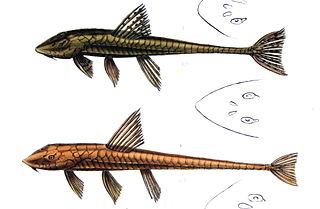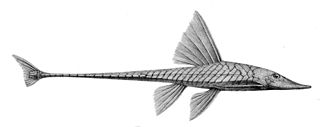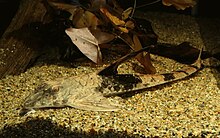
Baryancistrus is a genus of freshwater Loricariid catfish. They inhabit flowing sections of rivers, especially clearwater, in the basins of the Amazon and Orinoco in Brazil and Venezuela. The largest species reach up to 34 cm (13 in) in total length.

Rineloricaria is a genus of freshwater tropical catfish belonging to the family Loricariidae. They are commonly called whiptail catfish because of the long filament that grows out of the tip of the caudal fin that is characteristic of the genus. With the exception of R. altipinnis from Panama, they are native to the rivers of northern and central South America. Some species are regularly seen in the aquarium trade.

Farlowella is a genus of fish in the family Loricariidae native to South America. This genus is broadly distributed in Amazon, Orinoco, Paraná and coastal rivers of the Guyana Shield. It is absent from the Pacific slope of the Andes and from the coastal rivers of the Brazilian Shield. Many of these species are kept in aquariums. This genus has a unique body shape that resembles a thin stick of wood. The body is slender and elongate, often with a pronounced rostrum and a brownish color with two lateral dark stripes beginning at the tip of the rostrum, passing over the eyes and ending at the tail, which are periodically interrupted on the caudal peduncle.
Limatulichthys is a genus of catfish in the family Loricariidae and the subfamily Loricariinae.
Ixinandria steinbachi is the only species in the genus Ixinandria of catfish of the family Loricariidae.

Loricariichthys is a genus of catfishes of the family Loricariidae.

Sturisoma is a genus of armored catfishes native to Central and South America.
Harttia is a genus of armored catfishes native to South America.

Sturisomatichthys is a genus of armored catfishes native to Central and South America.
Dasyloricaria is a genus of armored catfishes native to Central and South America. The distribution of these species includes the northwestern South America on the Pacific slope of Colombia and Panama. Its distribution is restricted to the Pacific slope of the Andes, which is a unique pattern of distribution within the subfamily.

Spatuloricaria is a genus of armored catfishes native to South America and Panama.

Chaetostoma, also known as the bristlemouth catfish, is a genus of suckermouth armored catfishes native to South America with one species, C. fischeri, extending into Panama. Most species inhabit flowing rivers in the lower Andes and its foothills. Some species are kept in unheated aquaria.
Loricaria cuffyi is a species of catfish in the family Loricariidae. It is native to South America, where it occurs in the Essequibo River and Rio Negro basins in Guyana, as well as the Orinoco basin in Venezuela, with its type locality being designated as the Ireng River. The species was described on the basis of 36 specimens in 2020 by Alejandro Londoño-Burbano, Alexander Urbano-Bonilla, and Matthew R. Thomas. FishBase does not yet list this species.
Loricaria luciae, sometimes known as Lucia's whiptail, is a species of catfish in the family Loricariidae. It is native to South America, where it occurs in the Paraguay River basin in Argentina, Bolivia, Brazil, and Paraguay, ranging south to the Paraguay's confluence with the Paraná River. It is typically found in habitats with flowing water, ranging in size from arroyos to large rivers, where it generally occurs at a depth of less than 1.5 m in environments with soft substrates. It is sometimes seen in riffles and blackwater areas. The species reaches 18.9 cm in standard length and is believed to be a facultative air-breather. Its specific epithet, luciae, honors Lúcia H. Rapp Py-Daniel of the National Institute of Amazonian Research for her contributions to loricariid taxonomy and systematics.
Loricaria lundbergi is a species of catfish in the family Loricariidae. It is native to South America, where it occurs in the Rio Negro drainage basin in Brazil and Venezuela. It is typically found in blackwater habitats. An analysis of the stomach contents of a single individual found evidence of feeding on insect larvae, including those of the family Chironomidae, as well as sand and detritus. The species reaches 13.8 cm in standard length and is believed to be a facultative air-breather. Its specific epithet, lundbergi, honors John G. Lundberg of the Academy of Natural Sciences of Drexel University for his contributions to Neotropical ichthyology.
Loricaria pumila is a species of catfish in the family Loricariidae. It is native to South America, being known from Brazil, where it occurs in the Amazon River basin, near the mouths of the Tapajós and the Pará River, including the lower Tocantins River. It is reportedly typically found at depths between 3 and 29 m and distances of 15 to 1500 m from the shoreline, in environments characterized by a substrate of silt and organic detritus. An analysis of the stomach contents of a single individual found evidence of feeding on insects and aquatic insect larvae, as well as sand and detritus. The species reaches 8.1 cm in standard length and is believed to be a facultative air-breather. Its specific epithet, pumila, is derived from Latin and means "dwarf", referring to the small adult size of the species.
Loricaria spinulifera is a species of catfish in the family Loricariidae. It is native to South America, where it occurs in the Rio Negro basin in Brazil, including the Branco River and the Jauaperi River. It is typically seen in deep channels of blackwater rivers, where it is usually found at depths of 1.5 to 28 m and distances of 10 to 750 m from the shoreline. The environments in which the species occurs are characterized by substrates composed of sand, mud, and organic debris. Individuals of the species collected from deeper water tend to have smaller eyes and less prominent patterning than those collected from shallower areas. An analysis of the stomach contents of a single individual found evidence of feeding on aquatic insect larvae, as well as sand and detritus. The species reaches 13.8 cm in standard length and is believed to be a facultative air-breather. Its specific epithet, spinulifera, is derived from Latin and means "spine-bearing", referring to the conspicuous thorn-like odontodes found on its head.
Sturisomatichthys guaitipan is a species of catfish in the family Loricariidae. It is native to South America, where it occurs in the upper and middle Magdalena River basin in Colombia. The species was described in 2019 by Alejandro Londoño-Burbano and Roberto E. Reis as part of a taxonomic revision of the genus Sturisomatichthys.
Sturisomatichthys reinae is a species of catfish in the family Loricariidae. It is native to South America, where it occurs in the Baudó River basin in Colombia. The species was described in 2019 by Alejandro Londoño-Burbano and Roberto E. Reis as part of a taxonomic revision of the genus Sturisomatichthys.
Sturisomatichthys varii is a species of catfish in the family Loricariidae. It is native to South America, where it occurs in the San Juan River basin in Colombia. The species was described in 2019 by Alejandro Londoño-Burbano and Roberto E. Reis as part of a taxonomic revision of the genus Sturisomatichthys.








